Abstract
Emissions from the transportation sector due to the consumption of fossil fuels by conventional vehicles have been a major cause of climate change. Hybrid electric vehicles (HEVs) are a cleaner solution to reduce the emissions caused by transportation, and well-designed HEVs can also outperform conventional vehicles. This study examines various powertrain configurations and components to design a hybrid powertrain that can satisfy the performance criteria given by the EcoCAR Mobility Challenge competition. These criteria include acceleration, braking, driving range, fuel economy, and emissions. A total of five different designs were investigated using MATLAB/Simulink simulations to obtain the necessary performance metrics. Only one powertrain design was found to satisfy all the performance targets. This design is a P4 hybrid powertrain consisting of a 2.5 L engine from General Motors, a 150 kW electric motor with an electronic drive unit (EDU) from American Axle Manufacturing, and a 133 kW battery pack from Hybrid Design Services.
1. Introduction
One of the most significant issues that the world is currently facing is climate change, which is largely caused by the ever-increasing amount of greenhouse gas (GHG) emissions [1]. The transportation sector accounts for a large portion of GHG emissions. In Canada, the transportation sector was responsible for 24% of Canada’s GHG emissions in 2016 [2]. Because of this, there have been some efforts from various governments and the automotive industry to reduce the GHG emissions from vehicles, such as increased regulations on vehicle emissions standards [3]. The transportation sector has always been characterized by trends such as new technological developments, government mandates, varying regulations, environmental concerns, or changes in the global economic status [4]. Recent trends show that there has been a gradual decline in the popularity of fossil-fuel-powered internal combustion engine vehicles (ICEVs), while electric vehicles (EVs) and other zero-emission vehicles (ZEVs) are becoming increasingly more popular as alternatives [5,6]. A growing number of federal governments have announced aggressive timelines for the elimination of ICEVs, leading to a shift of focus toward EVs and battery technology by global automakers [7]. It was recently reported that the automotive industry will spend a minimum of $300 billion in the development of EVs over the next 10 years [8].
However, the transition from ICEVs to battery EVs (BEVs) has not been smooth because the battery technology development is still in its early stages [9]. Hybrid electric vehicles (HEVs) have proven to be a necessary bridge into the eventual complete BEV transition [10]. Advancements in electrified powertrain technology have also helped decrease the costs of HEVs, leading to their increased prevalence on the road. It was estimated that HEVs will achieve price parity with ICEVs by 2024 and become cheaper by 2025 [11]. The presence of an engine in HEVs also alleviates the range anxiety concern that still plagues the BEV segment [12]. Furthermore, with more resources being invested in EV technology, some of the recent HEVs are showing better performance and lower costs compared to ICEVs.
The term electrified powertrain is often used to describe several powertrain configurations that utilize electrical energy to produce propulsive torque [13]. Electrification within vehicles can take place in many different forms, including mild hybrid, strong hybrid, plug-in hybrid, and full battery EVs [14,15]. (1) Mild hybrid vehicles have the engine as the primary power source and use an electric motor with a small battery pack to produce electrical energy, which is used to assist with the engine output [16]. These vehicles usually do not have a dedicated driving mode that allows for propulsion via electrical power only, but the addition of electrification still helps reduce their fuel consumption in comparison to ICEVs. (2) Strong hybrid vehicles, also known as HEVs, use a combination of an engine and a battery-powered electric motor to drive the vehicle [17]. They have a more complex vehicle architecture and physical packaging requirements than mild hybrid and conventional vehicles. HEVs offer significant improvements in fuel consumption, as well as superior overall performance compared to similar conventional vehicles. (3) Plug-in hybrid electric vehicles (PHEVs) are similar to HEVs, with the main distinction being the PHEVs’ larger battery packs that can be recharged directly from grid electricity via a plug-in charger [18]. This allows PHEVs to have a larger EV-only range when compared to HEVs. (4) BEVs do not have an engine or any of the related internal combustion components. Instead, they solely utilize the battery-powered electric motor, which often comes with a very large battery pack, to provide propulsive torque to drive the vehicles. Like the PHEVs, the BEVs can also be recharged via a plug-in charger [19].
Several research works have been conducted to help develop and improve the design of electric powertrain in EVs. Dagci et al. [20] utilized planetary gear sets (PGs) to develop an automated design process for PG-based HEV systems focusing on both fuel economy and performance. The design process consisted of five major stages, and their case study results showed that a light-duty truck’s performance requirements could be fulfilled by various two-PG HEV designs without sacrificing fuel economy if the appropriate synthesis techniques for exploring the entire design space are developed. Kabalan et al. [21] investigated the potential of efficiency improvement of the simple series-parallel HEV powertrain using topology modification, which was the addition of gears for the components or a gearbox with a few numbers of ratios. The findings showed an efficiency decrease in one variant and an efficiency improvement in another variant with a fuel consumption result that was comparable to the standard Toyota Hybrid System. Vora et al. [22] introduced a model-based framework that incorporated powertrain simulation and battery degradation models to predict fuel consumption, electrical energy consumption, and battery replacements. These results were combined with economic assumptions to enable the exploration of a larger design space to provide better insights to vehicle integrators, component manufacturers, and buyers of HEVs. Lei et al. [23] demonstrated a novel approach for designing an electric powertrain to optimize energy consumption while maintaining vehicle performance and ride comfort. The requirements for power performance, energy consumption, and ride comfort were generated on the vehicle level. Subsequently, the generated requirements were applied to the subsystem level, where torque outputs, motor efficiency, and vehicle weight were the corresponding requirements. A multi-objective global optimization was carried out on the subsystem level while a constrained energy approach was proposed for the vehicle level. The final solution had a lightweight ratio of 93.5% and motor efficiency of 92%. Zhou et al. [24] outlined an optimal selection methodology for PHEV powertrain configuration utilizing optimization and a comprehensive evaluation of powertrain design schemes. To determine the performance potential of each configuration, a multi-objective powertrain optimization design was proposed and applied to series, parallel pre-transmission, output power-split, and multi-mode power-split powertrain configurations. The results suggested that the parallel pre-transmission configuration could be selected for optimal acceleration capacity, the multi-mode power-split configuration could be selected for optimal electric energy efficiency, and the output power-split configuration could be selected for optimal fuel economy.
In this work, the design and optimization of an HEV powertrain are examined in the context of a vehicle development competition. The University of Waterloo Alternative Fuels Team (UWAFT) is participating in the EcoCAR Mobility Challenge, sponsored by the United States (US) Department of Energy, General Motors (GM), and MathWorks, and managed by Argonne National Laboratory [25]. The competition tasks 12 North American universities to apply advanced propulsion systems, electrification, and vehicle connectivity to improve the energy efficiency of a 2019 Chevrolet Blazer while balancing factors such as emissions, safety, and consumer acceptability. This program provides the opportunity to apply the model-based design methodology using software-in-the-loop and hardware-in-the-loop to evaluate and optimize the HEV powertrain. This study outlines the process of developing an HEV powertrain using MATLAB and Simulink that is optimized for performance, fuel economy, and emissions. Powertrain configuration selection, as well as powertrain component (engine, motor, and battery) selection and sizing, is examined to evaluate the potential benefits and drawbacks for each layout. This study focuses on the first two steps in the model-based design methodology, as shown in Figure 1. The contribution of this study is the in-depth description of a powertrain design process using the model-based design methodology and software modeling and simulation to electrify a conventional vehicle, as well as the optimization of the hybrid powertrain performance by considering different design parameters.

Figure 1.
Schematic of the model-based design methodology.
The rest of this paper is organized as follows: Section 2 describes various available hybrid powertrain configurations; Section 3 provides the design criteria and constraints; Section 4 and Section 5 outline the powertrain design process and analyze the simulation results of the built-in vehicle model in MATLAB and Simulink; Section 6 provides some concluding remarks.
2. Hybrid Powertrain Configurations
From a vehicle architecture standpoint, HEV powertrains can be classified into three main categories, which are series, parallel, and series-parallel split. These categories are defined by the vehicle’s overall power flow and torque path.
In a series HEV powertrain, the engine does not provide propulsive torque to drive the vehicle. Its main function is to convert potential energy from fuel to mechanical energy which is then converted to electrical energy using a generator. The electrical energy is used to propel the motor via an inverter. This configuration allows for the engine speed to be controlled independently from the vehicle speed, which means that the engine can be controlled to run at the optimal speed to minimize losses incurred in the electricity generation process [26]. The electric motor used to drive the vehicle receives power from the engine or the battery pack as shown in Figure 2.
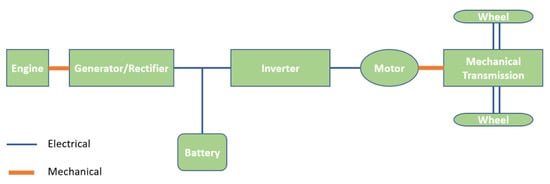
Figure 2.
Schematic of a series hybrid powertrain.
In a parallel HEV powertrain, the engine, similar to conventional vehicles, provides propulsive torque directly to the wheels to drive the vehicle. An electric motor, powered by a battery pack, is also mechanically coupled to the driveline, allowing it to boost the power output of the engine. A mechanical coupler combines the torques generated from the engine and motor and delivers the resulting torque to the wheels. The engine torque and the motor torque can be controlled individually, but the speed of the engine and the motor each have a fixed proportion to the overall vehicle speed. An example of the parallel HEV powertrain configuration is shown in Figure 3.
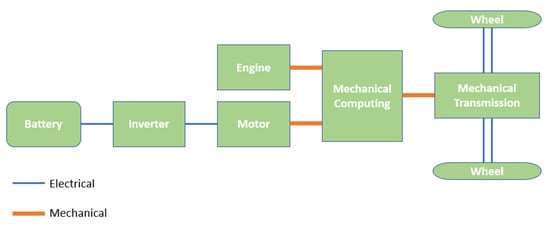
Figure 3.
Schematic of a parallel hybrid powertrain.
The series-parallel HEV powertrain, shown in Figure 4, is a significantly more complex configuration as it allows for both series and parallel driveline functionality, optimizing the vehicle for various driving scenarios [26]. This is enabled by a mechanical coupling component that can either connect or disconnect the power output of the engine from the vehicle’s main driveline.
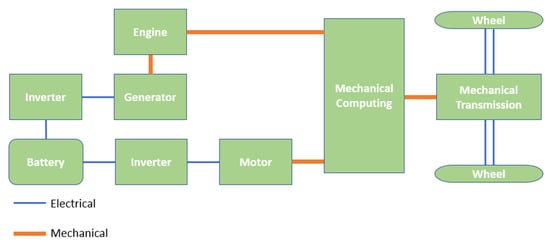
Figure 4.
Schematic of a series-parallel split hybrid powertrain.
3. Powertrain Design Requirements and Constraints
3.1. Vehicle Performance Metrics
The first step in the HEV powertrain designing process involves establishing design objectives and evaluation criteria. The vehicle technical specifications (VTS) were established by the EcoCAR competition as the key performance indicators used to evaluate the potential designs in terms of overall performance. Table 1 lists all the VTS metrics targeted for the powertrain.

Table 1.
Summary of the target vehicle technical specifications.
3.2. Available Options for Powertrain Configurations and Components
Aside from the VTS, other technical requirements and limitations were imposed to ensure the creation of a viable propulsion system design that aligns with the core vision of the competition. For instance, P0 and P4 powertrain architectures, shown in Figure 5, were pre-approved by the EcoCAR organizing committee and, hence, teams were encouraged to use these architectures. In the P0 architecture, an electric motor is connected with an internal combustion engine through a belt, on the front-end accessory drive. In the P4 architecture, the electric motor, located in the rear axle drive, is connected through a gear mesh on the rear axle of the vehicle and decoupled from the internal combustion engine.
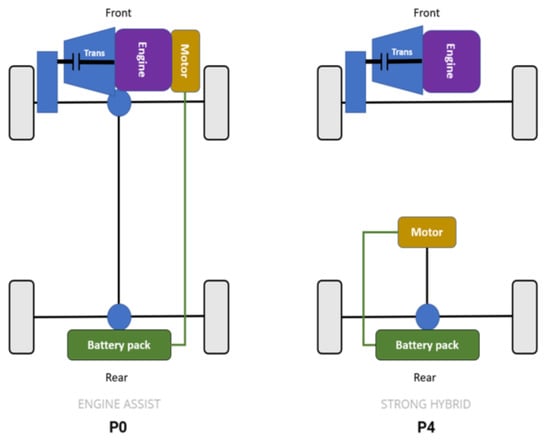
Figure 5.
Viable powertrain architectures.
The competition also limits the options for powertrain components such as the engine, motor, and battery to ensure a certain level of safety control. Due to confidential reasons, the exact details of these components, despite being used in the MATLAB/Simulink simulation, are not disclosed in this study; instead, the information given is the high-level specifications of the components. Table 2 shows two engine options, which are manufactured by GM.

Table 2.
Overview of engine options.
The electric system, consisting of an electric motor and a battery pack, must be designed to ensure that components are not only compatible with each other but also satisfy the objective to produce a vehicle optimized for fuel economy. The power levels of the two systems should be matched such that the battery pack’s discharge power capabilities meet the requirements of the motor. Figure 6 outlines two available battery packs and four corresponding motors. The two options for battery include a smaller pack, the Malibu hybrid battery (HEV4), with a maximum discharge power of 53 kW made by GM, and a larger pack with a maximum discharge power of 133 kW custom-made by Hybrid Design Services (HDS). The HDS pack consists of 768 2-Ah Samsung cells (lithium nickel manganese cobalt oxide), with 96 cells in series and eight in parallel. The smaller GM HEV4 pack is compatible with two motors which are the American Axle Manufacturing (AAM) EDU2 and the Emrax 228, while the larger HDS pack is compatible with the Phi Power 217 s and the AAM EDU4.
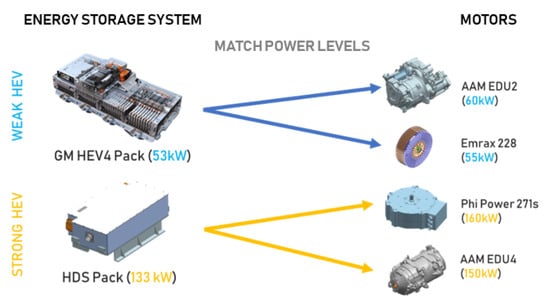
Figure 6.
Electric system component options.
Energy recovery capability should also be considered to optimize fuel economy. The energy recovery is usually maximized by using regenerative braking as the primary means of slowing the vehicle. The charging capability of the battery is the main factor determining the amount of energy that can be recovered through regenerative braking. Table 3 shows the regenerative capabilities for the two battery options.

Table 3.
Battery regenerative braking capability. (GM, General Motors; HDS, Hybrid Design Services.)
The HDS pack can bring the vehicle, with an assumed mass of 1730 kg, to a complete stop from 93 km/h using only regenerative braking at a deceleration rate of 3 m/s2, whereas the HEV4 pack can only slow the vehicle from 45 km/h before the use of mechanical brakes is required.
4. Powertrain Modeling in MATLAB/Simulink
This section details the modeling and simulation environment setup and the baseline performance results of several powertrain architectures. MATLAB/Simulink, specifically the Powertrain Blockset™, was utilized as the primary tool in the development of the powertrain model to explore various architectures consisting of different components. The powertrain model is derived from a Simulink model for the stock 2019 Chevrolet Blazer provided by MathWorks. The model has four unique subsystems, including the powertrain, drivetrain, controllers, and driver input, as shown in Figure 7. These systems were developed in parallel with component selection and architecture refinement to achieve the best results. MATLAB scripts were developed to efficiently evaluate various architectures and perform component selection sweeps.
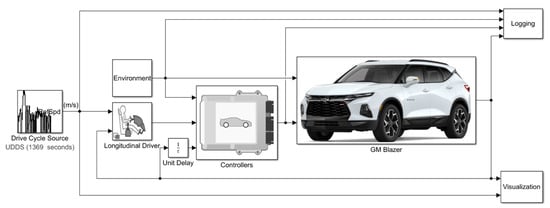
Figure 7.
High-level vehicle model in Simulink.
4.1. Powertrain Components Modeling
Basic built-in blocks from the Simulink Powertrain Blockset™ were used to model each component being considered. The engine and motor blocks rely on lookup tables generated via the Model-Based Calibration Toolbox™ and simplified dynamics, while the battery block is represented by an equivalent circuit model. The built-in blocks for the components are shown in Figure 8. Linear interpolation between lookup tables breakpoints has been proven to be sufficient for standard drive cycle modeling [26].

Figure 8.
The engine block, motor block, and battery block in Simulink (from left to right) [27,28,29].
The engine model used in this study is based on the built-in “Mapped SI Engine” block [27]. This block uses a series of lookup tables to calculate the input speed and torque command. Significant lookup tables include the gas mass flow, fuel mass flow, exhaust manifold gas temperature, brake-specific fuel consumption, CO, CO2, NOx, and particulate matter (PM) emissions. The actuator blocks use transfer functions to determine the actuator dynamics at a given time. The emissions calculations are detailed by a set of functions that determine the level of filtrated emissions by a catalyst. These calculations assume that the operating pressure and temperature of the engine are constant and that the lookup table values are representative of practical applications.
The motor model is based on the built-in “Mapped Motor” block [28]. This block uses a lookup table to determine the motor efficiency on the basis of input torque and motor speed. Another lookup table of torque-speed data is utilized to determine maximum torque values and rotational speeds. These lookup tables were populated using data obtained directly from the motor manufacturers. The required current is calculated using the battery voltage and the mechanical power, which is obtained from speed and torque commands.
The battery model is based on the built-in “Equivalent Circuit Battery” block [29]. The parameters of the first-order equivalent circuit model were provided by the manufacturers and populated into lookup tables. The first-order equivalent circuit model has been shown to be sufficiently accurate for the purpose of battery voltage estimation [30,31]. This battery block determines the battery output voltage from the required current and operating temperature. The state of charge is calculated by coulomb counting. The temperature is assumed to be constant during operation, and the lookup tables are assumed to be representative of battery conditions. These assumptions can be made as the changes in temperature are negligible during battery operation within the standard drive cycles.
4.2. Energy Consumption Modeling
In an ICEV, only low-level controls such as individual component controllers are required. In an HEV, however, the vehicle controller needs to also determine how much power should be delivered by each of the energy sources in the vehicle [32,33]. For the UWAFT-designed vehicle, one objective is to minimize the fuel economy, which would require an effective energy management strategy. UWAFT implemented the equivalent consumption minimization strategy (ECMS), which is a method with a low computational complexity that has been used widely in hybrid vehicle applications. The ECMS is based on the concept that there is an equivalence between electrical energy and fuel energy [34]. This equivalence is evaluated by considering the average energy paths from the fuel tank to the storage of the electrical energy. In the ECMS functions, for each time t with a time step of ∆t, parameters such as acceleration, speed, wheel speed, and wheel torque are measured or evaluated and used to calculate the equivalence factor. The equivalence factor determines the fuel equivalent of the electrical energy on the basis of whether the battery is being charged or discharged. This factor is used in the cost function which is minimized by adjusting the control variables. The optimal control variables then regulate the amount of torque that is provided by the electrical and fuel paths.
As previously discussed, the primary powertrain components (engine, motor, and battery) were modeled in Simulink using lookup tables provided by the component manufacturers. Without the physical components to validate these tables, it was assumed that these individual components were modeled to a sufficient degree of accuracy. There were several other assumptions that may have also caused some variance in the simulated fuel economy results. For instance, transmission shift time is a factor that can affect the fuel economy results; however, in this study, it was assumed that the transmission shift time could be neglected. The shift time used in the model was 350 ms. It has been shown that vehicle shifting tends to range from 50 ms to approximately 500 ms [35]. Therefore, different transmission shift times, from 50 to 500 ms, were run and analyzed using the stock vehicle model to see the corresponding fuel economy, as shown in Figure 9. This analysis showed a maximum difference in fuel economy of 1.9% which is small enough to be reasonably neglected in practical applications. Another assumption, not formally evaluated but inherent to the model, is environmental conditions (wind, grade, etc.) being constant. Deviations from these environmental conditions were not considered in the basic architectural design and selection. Overall, an upper estimate of the variance in the fuel economy results was ±1.65 mpg, suggesting reasonably accurate fuel economy modeling results.
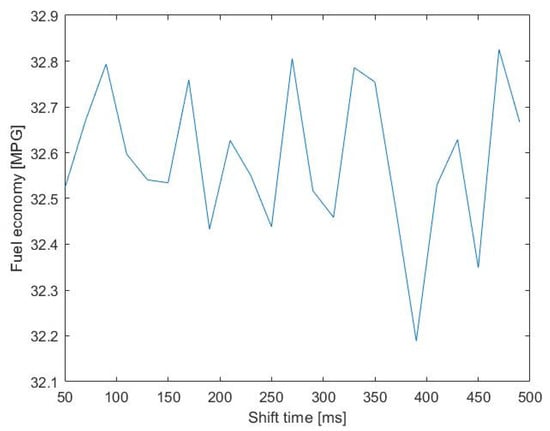
Figure 9.
Fuel economy vs. transmission shift time.
5. Powertrain Simulation Results in MATLAB/Simulink
After inputting the specification parameters for the engines, motors, and batteries, and implementing the ECMS in the vehicle controller, the powertrain model was run in Simulink. Only the mechanically feasible designs were considered. For instance, only the 1.5 L engine and the Phi Power 271 s were considered for the P0 configuration because the spacing requirement for both the engine and motor in the front of the vehicle cannot accommodate any other types of engine and motor. For the P4 configuration, only the 2.5 L engine was considered for performance purposes, since, at times, the engine will have to drive the car completely by itself and, thus, will need more power. The matching electrical components were also considered. The simulation used two drive cycles to test the performance of each design, which were the urban dynamometer driving schedule (UDDS) and the highway fuel economy driving schedule (HWFET). Each of the drive cycles was run five times consecutively to obtain a longer running time. The UDDS drive cycle represents city driving and the HWFET drive cycle represents highway driving. The values shown in Table 4 are the combination of the results from running these two drive cycles, with the unsatisfactory performance metrics when considering the competition targets being labeled in red.

Table 4.
Summary of performance results of various powertrain designs in Simulink. Unsatisfactory performance metrics when considering the competition targets are labeled in red.
From Table 4, it can be seen that, even though all five designs seem viable and satisfy most of the EcoCAR competition targets, only one design gives a fully satisfactory performance. From a high-level perspective, this design is a P4 hybrid powertrain consisting of a 2.5 L inline-four engine from GM, a 150 kW electric motor with an integrated 9.04:1 gear reduction, also known as an electronic drive unit (EDU) from AAM, and a 133 kW battery pack provided by HDS. Figure 10 summarizes the selected powertrain configuration and components. The Simulink simulation results using the vehicle model and the ECMS control strategy are shown in Table 5, in comparison with the competition targets.

Figure 10.
Selected vehicle powertrain configurations and components.

Table 5.
Simulated vehicle performance of the selected design.
By utilizing the Simulink Powertrain Blockset™, five different powertrain designs were efficiently examined, and one was selected to be the final design to be submitted to the EcoCAR competition. The final design was shown to satisfy all of the competition targets by simulations in MATLAB/Simulink. It should be noted that this study only focused on the technical design process of the hybrid powertrain from the modeling and simulation standpoints. Other design aspects, to be addressed in our future works, such as cost analysis and mechanical/electrical risks, will also be considered before the real-life integration of the selected powertrain configuration and components into the vehicle.
6. Conclusions
This study investigated two powertrain configurations, two engines, four electric motors, and two battery packs in the process of designing a hybrid electric vehicle powertrain. The final design had to satisfy the performance requirements given by the EcoCAR Mobility Challenge competition. The model-based design methodology was utilized, specifically the first two steps, which are the definition of design requirements and software modeling and simulation. Five different designs were modeled and simulated using the Simulink Powertrain Blockset™ to obtain the performance metrics, including acceleration, braking, driving range, fuel economy, and emissions. The equivalent consumption minimization strategy was used as the energy management strategy in all examined designs. The simulation results indicated that only one design was able to meet all the given criteria. This final design was a P4 hybrid powertrain with a 2.5 L engine from GM, a 150 kW electric motor with an EDU from AAM, and a 133 kW battery pack from HDS. This study also showed that software modeling and simulation can be a good first step in the overall vehicle design process, as it can provide some general ideas of how different powertrain components such as engines, motors, and batteries work together in different powertrain architectures. MATLAB/Simulink was also validated to be a good modeling and simulation tool for powertrain design. Further research effort will focus on the next steps in the model-based design research, especially the software-in-the-loop and hardware-in-the-loop, to obtain and validate the final vehicle design. Another aspect that we will focus on in our future research is the concept of connected autonomous vehicles, where we will use technology to steer, accelerate, and brake with little to no human input.
Author Contributions
Conceptualization, M.-K.T., M.A., and R.F.; methodology, M.-K.T. and M.A.; software, M.-K.T. and M.A.; formal analysis, M.A.; writing—original draft preparation, M.-K.T.; writing—review and editing, M.A., S.P. and M.F.; visualization, M.-K.T. and M.A.; supervision, R.F., S.P. and M.F.; funding acquisition, R.F. and M.F. All authors have read and agreed to the published version of the manuscript.
Funding
This research was funded by the Natural Sciences and Engineering Research Council of Canada (NSERC) and the Collaborative Research and Development Grants—Optimizing Hybrid Electric Powertrains for Connected and Automated Vehicles (CAV) (UWAFT—ECOCAR 4—with General Motors of Canada), CRDPJ 537104-18.
Acknowledgments
This work was supported by the equipment and manpower from the University of Waterloo Alternative Fuels Team. Special thanks are given to Danielle Skeba, Vincent Leung, and Ian ShingHei Kwok for their contribution in editing the paper.
Conflicts of Interest
The authors declare no conflict of interest.
References
- Aldhafeeri, T.; Tran, M.-K.; Vrolyk, R.; Pope, M.; Fowler, M. A Review of Methane Gas Detection Sensors: Recent Developments and Future Perspectives. Inventions 2020, 5, 28. [Google Scholar] [CrossRef]
- Shamsi, H.; Tran, M.-K.; Akbarpour, S.; Maroufmashat, A.; Fowler, M. Macro-Level Optimization of Hydrogen Infrastructure and Supply Chain for Zero-emission Vehicles on a Canadian Corridor. J. Clean. Prod. 2020, 125163. [Google Scholar] [CrossRef]
- Taefi, T.T.; Kreutzfeldt, J.; Held, T.; Fink, A. Supporting the adoption of electric vehicles in urban road freight transport—A multi-criteria analysis of policy measures in Germany. Transp. Res. Part A Policy Pract. 2016, 91, 61–79. [Google Scholar] [CrossRef]
- Fathabadi, H. Utilization of electric vehicles and renewable energy sources used as distributed generators for improving characteristics of electric power distribution systems. Energy 2015, 90, 1100–1110. [Google Scholar] [CrossRef]
- Mevawalla, A.; Panchal, S.; Tran, M.-K.; Fowler, M.; Fraser, R. Mathematical Heat Transfer Modeling and Experimental Validation of Lithium-Ion Battery Considering: Tab and Surface Temperature, Separator, Electrolyte Resistance, Anode-Cathode Irreversible and Reversible Heat. Batteries 2020, 6, 61. [Google Scholar] [CrossRef]
- Panchal, S.; Gudlanarva, K.; Tran, M.-K.; Fraser, R.; Fowler, M. High Reynold’s Number Turbulent Model for Micro-Channel Cold Plate Using Reverse Engineering Approach for Water-Cooled Battery in Electric Vehicles. Energies 2020, 13, 1638. [Google Scholar] [CrossRef]
- Garcia, R.; Gregory, J.; Freire, F. Dynamic fleet-based life-cycle greenhouse gas assessment of the introduction of electric vehicles in the Portuguese light-duty fleet. Int. J. Life Cycle Assess 2015, 20, 1287–1299. [Google Scholar] [CrossRef]
- Reuters, Exclusive: VW, China Spearhead $300 billion Global Drive to Electrify Cars. Available online: https://www.reuters.com/article/us-autoshow-detroit-electric-exclusive-idUSKCN1P40G6 (accessed on 23 October 2020).
- Tran, M.-K.; Fowler, M. A Review of Lithium-Ion Battery Fault Diagnostic Algorithms: Current Progress and Future Challenges. Algorithms 2020, 13, 62. [Google Scholar] [CrossRef]
- Hajimiragha, A.; Canizares, C.A.; Fowler, M.W.; Elkamel, A. Optimal Transition to Plug-In Hybrid Electric Vehicles in Ontario, Canada, Considering the Electricity-Grid Limitations. IEEE Trans. Ind. Electron. 2010, 57, 690–701. [Google Scholar] [CrossRef]
- Bloomberg, “Electric Cars May Be Cheaper Than Gas Guzzlers in Seven Years”. Available online: https://news.bloomberglaw.com/environment-and-energy/electric-cars-may-be-cheaper-than-gas-guzzlers-in-seven-years (accessed on 23 October 2020).
- Bonges, H.A.; Lusk, A.C. Addressing electric vehicle (EV) sales and range anxiety through parking layout, policy and regulation. Transp. Res. Part A Policy Pract. 2016, 83, 63–73. [Google Scholar] [CrossRef]
- Sabri, M.F.M.; Danapalasingam, K.A.; Rahmat, M.F. A review on hybrid electric vehicles architecture and energy management strategies. Renew. Sustain. Energy Rev. 2016, 53, 1433–1442. [Google Scholar] [CrossRef]
- Wu, G.; Zhang, X.; Dong, Z. Powertrain architectures of electrified vehicles: Review, classification and comparison. J. Frankl. Inst. 2015, 352, 425–448. [Google Scholar] [CrossRef]
- Tran, M.-K.; Sherman, S.; Samadani, E.; Vrolyk, R.; Wong, D.; Lowery, M.; Fowler, M. Environmental and Economic Benefits of a Battery Electric Vehicle Powertrain with a Zinc–Air Range Extender in the Transition to Electric Vehicles. Vehicles 2020, 2, 398–412. [Google Scholar] [CrossRef]
- Benajes, J.; García, A.; Monsalve-Serrano, J.; Martínez-Boggio, S. Optimization of the parallel and mild hybrid vehicle platforms operating under conventional and advanced combustion modes. Energy Convers. Manag. 2019, 190, 73–90. [Google Scholar] [CrossRef]
- Di Cairano, S.; Bernardini, D.; Bemporad, A.; Kolmanovsky, I.V. Stochastic MPC with Learning for Driver-Predictive Vehicle Control and its Application to HEV Energy Management. IEEE Trans. Control Syst. Technol. 2014, 22, 1018–1031. [Google Scholar] [CrossRef]
- Cheng, H.; Wang, L.; Xu, L.; Ge, X.; Yang, S. An Integrated Electrified Powertrain Topology With SRG and SRM for Plug-In Hybrid Electrical Vehicle. IEEE Trans. Ind. Electron. 2020, 67, 8231–8241. [Google Scholar] [CrossRef]
- Hawkins, T.R.; Gausen, O.M.; Strømman, A.H. Environmental impacts of hybrid and electric vehicles—A review. Int. J. Life Cycle Assess 2012, 17, 997–1014. [Google Scholar] [CrossRef]
- Dagci, O.H.; Peng, H.; Grizzle, J.W. Hybrid Electric Powertrain Design Methodology With Planetary Gear Sets for Performance and Fuel Economy. IEEE Access 2018, 6, 9585–9602. [Google Scholar] [CrossRef]
- Kabalan, B.; Vinot, E.; Yuan, C.; Trigui, R.; Dumand, C.; Hajji, T.E. Efficiency Improvement of a Series-Parallel Hybrid Electric Powertrain by Topology Modification. IEEE Trans. Veh. Technol. 2019, 68, 11523–11531. [Google Scholar] [CrossRef]
- Vora, A.P.; Jin, X.; Hoshing, V.; Saha, T.; Shaver, G.; Varigonda, S.; Wasynczuk, O.; Tyner, W.E. Design-space exploration of series plug-in hybrid electric vehicles for medium-duty truck applications in a total cost-of-ownership framework. Undefined 2017, 202, 662–672. [Google Scholar]
- Lei, F.; Bai, Y.; Zhu, W.; Liu, J. A novel approach for electric powertrain optimization considering vehicle power performance, energy consumption and ride comfort. Energy 2019, 167, 1040–1050. [Google Scholar] [CrossRef]
- Zhou, X.; Qin, D.; Hu, J. Multi-objective optimization design and performance evaluation for plug-in hybrid electric vehicle powertrains. Appl. Energy 2017, 208, 1608–1625. [Google Scholar] [CrossRef]
- EcoCAR Mobility Challenge. Available online: https://avtcseries.org/ecocar-mobility-challenge/ (accessed on 8 September 2018).
- Mi, C.; Masrur, M. Hybrid Electric Vehicles: Principles and Applications with Practical Perspectives, 2nd ed.; Wiley: West Sussex, UK, 2017. [Google Scholar]
- MathWorks. Mapped SI Engine. Available online: https://www.mathworks.com/help/autoblks/ref/mappedsiengine.html (accessed on 2 July 2019).
- MathWorks. Mapped Motor. Available online: https://www.mathworks.com/help/autoblks/ref/mappedmotor.html (accessed on 2 July 2019).
- MathWorks. Equivalent Circuit Battery. Available online: https://www.mathworks.com/help/autoblks/ref/equivalentcircuitbattery.html (accessed on 2 July 2019).
- Tran, M.-K.; Fowler, M. Sensor Fault Detection and Isolation for Degrading Lithium-Ion Batteries in Electric Vehicles Using Parameter Estimation with Recursive Least Squares. Batteries 2020, 6, 1. [Google Scholar] [CrossRef]
- Tran, M.-K.; Mevawala, A.; Panchal, S.; Raahemifar, K.; Fowler, M.; Fraser, R. Effect of integrating the hysteresis component to the equivalent circuit model of Lithium-ion battery for dynamic and non-dynamic applications. J. Energy Storage 2020, 32, 101785. [Google Scholar] [CrossRef]
- Zhang, H.; Wang, J. Adaptive Sliding-Mode Observer Design for a Selective Catalytic Reduction System of Ground-Vehicle Diesel Engines. IEEE/ASME Trans. Mechatron. 2016, 21, 2027–2038. [Google Scholar] [CrossRef]
- Zhang, H.; Wang, J. Active Steering Actuator Fault Detection for An Automatically-steered Electric Ground Vehicle. IEEE Trans. Veh. Technol. 2016, 66, 3685–3702. [Google Scholar] [CrossRef]
- Musardo, C.; Rizzoni, G.; Guezennec, Y.; Staccia, B. A-ECMS: An Adaptive Algorithm for Hybrid Electric Vehicle Energy Management. Eur. J. Control 2005, 11, 509–524. [Google Scholar] [CrossRef]
- Asadi, B.; Vahidi, A. Predictive Cruise Control: Utilizing Upcoming Traffic Signal Information for Improving Fuel Economy and Reducing Trip Time. IEEE Trans. Control Syst. Technol. 2011, 19, 707–714. [Google Scholar] [CrossRef]
Publisher’s Note: MDPI stays neutral with regard to jurisdictional claims in published maps and institutional affiliations. |
© 2020 by the authors. Licensee MDPI, Basel, Switzerland. This article is an open access article distributed under the terms and conditions of the Creative Commons Attribution (CC BY) license (http://creativecommons.org/licenses/by/4.0/).